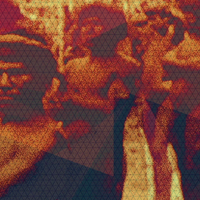A iconicidade no design de André Vallias: uma análise baseada na semiótica
Esta pesquisa explora a influência da prática poética de André Vallias na sua atividade como designer pela produtora Refazenda, focalizando nas interações entre essas duas áreas. O objetivo geral é evidenciar as interseções entre poesia e design em suas produções e como o pensamento decorrente desta prática, especialmente a partir do seu conceito de diagrama, se manifesta em sua atuação. Adotando a semiótica de Peirce como referencial teórico, este estudo de caso investiga como elementos verbais, visuais e interativos se integram nas suas criações, buscando compreender reverberações recíprocas entre a poesia experimental e o design contemporâneo. A metodologia adotada é qualitativa e combina a análise semiótica das produções da Refazenda com a entrevista concedida pelo poeta e designer. Da amostra constituída pelas publicações disponíveis no site da produtora, seis das mais representativas para os interesses da pesquisa foram selecionadas para a análise baseada nas dimensões sintática, semântica e pragmática. A entrevista com o designer forneceu uma visão aprofundada sobre suas influências e práticas, ajudando a contextualizar os dados obtidos nas análises por meio da triangulação. Os resultados revelam que a prática poética de Vallias é um fator determinante em suas produções de design, evidenciando a perspectiva integradora de uma linguagem híbrida. A análise demonstra como a iconicidade, uma propriedade eminentemente associada ao signo icônico e à categoria de primeiridade de Peirce, molda a estética, as potencialidades de significação e a pragmática das produções, revelando a interseção entre poesia e design. As conclusões da tese ressaltam a relevância da prática poética no design gráfico de Vallias, identificando a adoção de perspectivas criativas na combinação de diferentes mídias. O trabalho contribui para a compreensão teórica sobre os cruzamentos entre poesia e design e não apenas amplia o conhecimento sobre a influência recíproca dessas áreas, como também destaca a importância da abordagem interdisciplinar na análise de suas práticas.
This research explores the influence of André Vallias’ poetic practice on his work as a designer for the production company Refazenda, focusing on the interaction between these two areas. The general objective is to highlight the intersections between poetry and design in his productions and how the thinking arising from this practice, especially from his concept of diagram, manifests itself in his work. Adopting Peirce's semiotics as a theoretical framework, this case study investigates how verbal, visual and sound elements are integrated in his creations, seeking to understand the reciprocal influence between these two areas in the context of contemporary design. The methodology adopted is qualitative and combines the semiotic analysis of Refazenda’s productions with the interview given by the poet and designer. From the sample constituted by the publications available on the company's website, six of the most representative for the research interests were selected for analysis based on the syntactic, semantic and pragmatic dimensions. The interview with the designer provided an in-depth view of his influences and practices, helping to contextualize the data obtained in the analyses through triangulation. The results reveal that Vallias’ poetic practice is a determining factor in his design productions, highlighting the integrative perspective of a hybrid language. The analysis demonstrates how iconicity, a property eminently associated with the iconic sign and Peirce's category of firstness, shapes the aesthetics, the potentialities of meaning and the pragmatics of the productions, revealing the intersection between poetry and design. The conclusions of the thesis emphasize the relevance of poetic practice in Vallias’ graphic design, identifying the adoption of creative perspectives in the combination of different media. The work contributes to the theoretical understanding of the intersections between poetry and design and not only expands knowledge about the reciprocal influence of these areas, but also highlights the importance of the interdisciplinary approach in the analysis of their practices.
